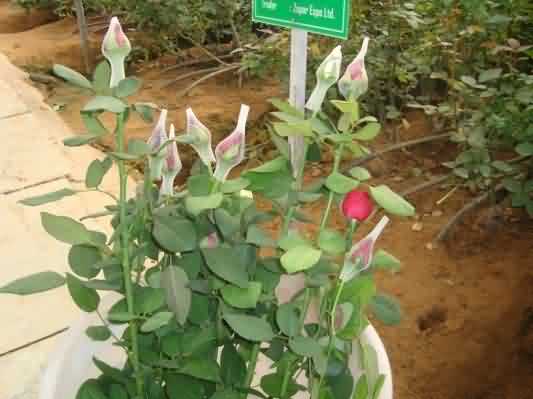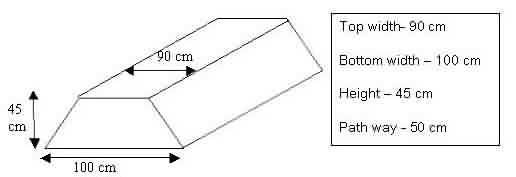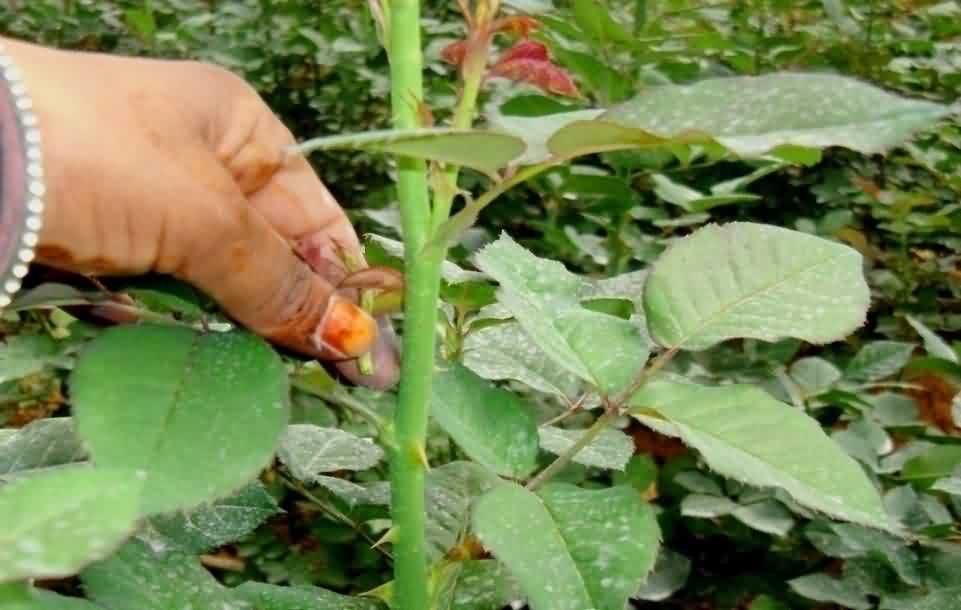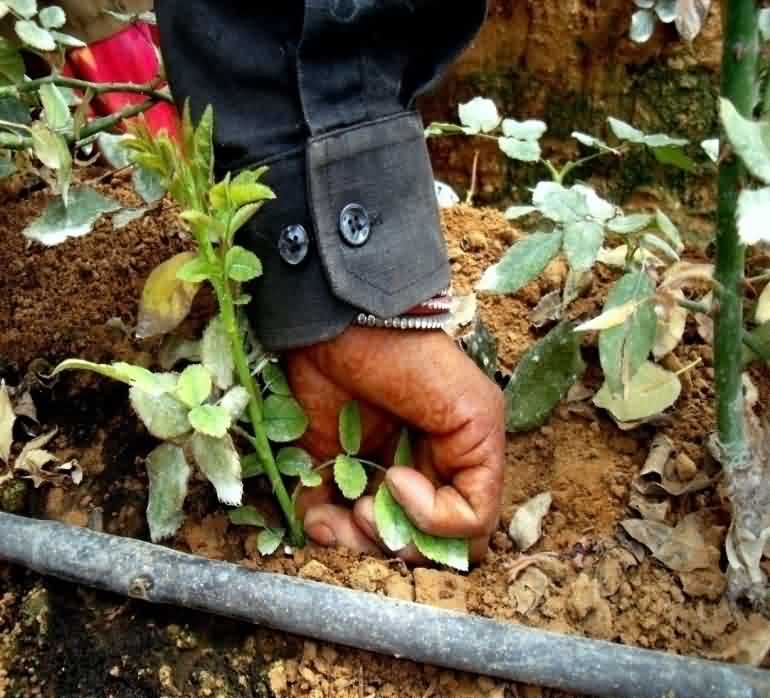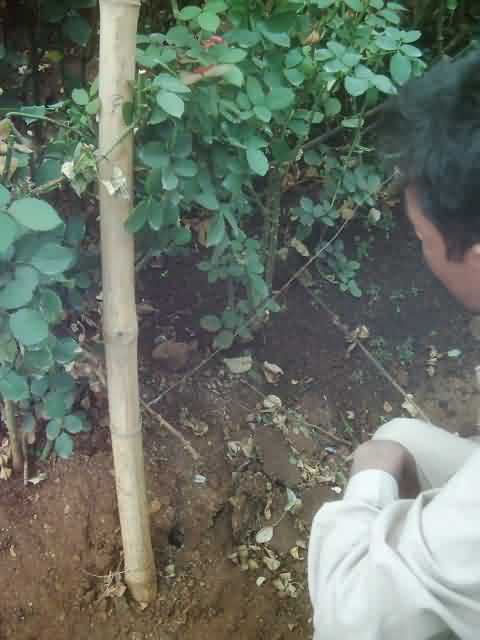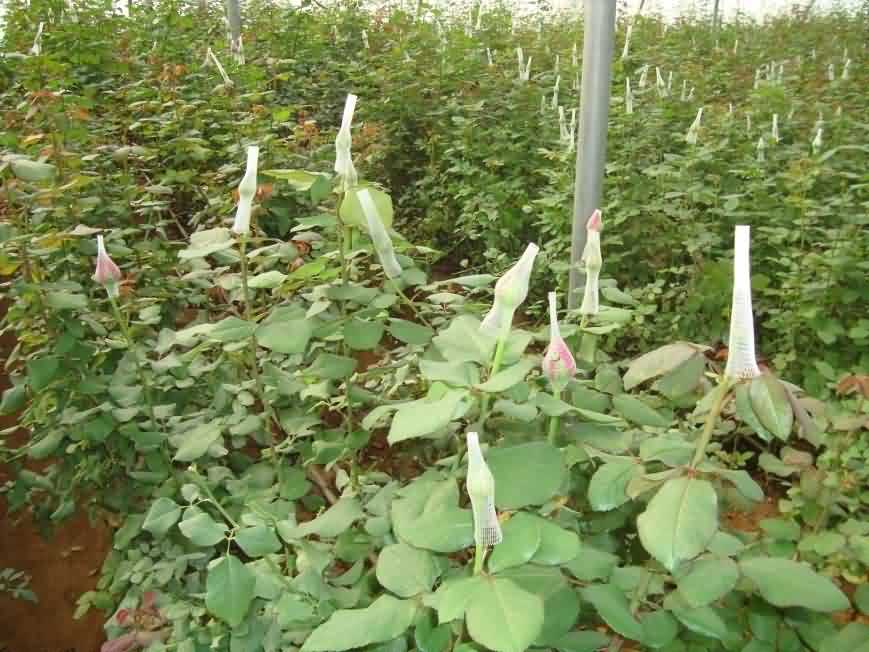डच रोज कट फलावर की खेती कैसे करें।
Floriculture is just like a fashion industry. Cultivation of cut flowers Rose, Gerbera, Carnation is profitable crop for farmers. Selection of right variety of flowers is an important tool in commercial floriculture. Battles in the international flower market can be won with producing quality of flowers, strong marketing & financial assistance so a grower should be very careful about selection of varieties.
Climatic requirement of Cut flowers:
| Name of crop | Commercial life cycle(Yrs) | Day (0c) | Night (0c) | Humidity (%) | Light intensity (Lux) | Co2 Conc.(ppm) |
| Rose | 6.5 – 7 | 24-28 | 18.5-20 | 65-70 | 60000-70000 | 800-1000 |
| Gerbera | 2.5 -3 | 20-24 | 18-21 | 60-65 | 40000-50000 | 800-1000 |
| Carnation | 2 – 2.5 | 16-20 | 10-12 | 60-65 | 40000-50000 | 800-1000 |
Selection of cultivar:
- Sustainable to tropical climate: The varieties selected should be suitable for growing in tropical condition and it should have mainly excellent quality production.
- Production and stem length: The varieties selected should be resistant to disease and pest. A grower should select high yielding variety in combination with high market demand and mainly varieties which have longer stem length.
Colour percentage:
In general roses of different colours such as red, yellow, pink, orange, white, bicolour etc are grown & sold in market. The red coloured flowers are highly preferable in markets. It is recommended to have the following mix of colors.
| Colour | Percentage |
| Red | 40 % |
| Yellow | 20 % |
| Pink | 20 % |
| Orange | 10 % |
| White | 10 % |
Steps in plantation of cut flowers (Rose, Gerbera, Carnation):
Remove pebbles from the bed before plantation. Adequate moisture must be available in the soil at the time of plantation. The seedlings should be dipped in Bavistin (0.2%) solution and then planted on bed. Plantation to be done by making holes or trenches on bed in a zigzag way. Planting should be avoided during the hottest period of the day/year and it should be done either in the morning or late in the evening.
Care after plantation:
After planting, the soil around the plants must be kept humid and should not be over irrigated. Irrigate the plant with hose pipe immediately after plantation. During periods with strong sunshine or high temperature, the young plants must frequently be given an over head spray with water to assist establishment & reduce post planting losses. For first three weeks the irrigation should be done only by using hose sprayer & later on irrigation should be done by drip system. Mortality replacement should be done within the week after plantation.
Fungicides drenching schedule
| S.No. | Fungicide | Dose | Time of drenching |
| 1 | Bavistin | 1 g/litre | Immediately after plantation |
| 2 | M – 45 | 1 g/litre | 3 days after plantation |
| 3 | Bavistin | 1.5 g/litre | 7 days after plantation |
| 4 | M – 45 | 1.5 g/litre | 10 days after plantation |
| 5 | Bavistin | 2 g/litre | 14 days after plantation |
| 6 | M – 45 | 2 g/litre | 17 days after plantation |
Market demand:
Farmer should visit the market and study the following points.
- Average selling price
- varieties in the demand
- Preference of colours, peak demand period major national and international market for the product
By exporting flowers to various countries a grower can fetch good prices. To capture export market he must produce good quality and quantity of flowers. He should study the international market by visiting the websites of different auctions in different countries, and websites of main traders and retailers in different countries. This will help him to get ideas about market and varieties performances. Demand season for flowers is generally from October to March. It coincides with marriage season, festival like Deepawali, Christmas and important event like new years and valentine. Trends in prices need to be considered while planning cut flowers productions
CULTIVATION OF DUTCH ROSE
There are three basic groups of roses traded within the international markets as mentioned below.
| Sr. No. | Type of Roses | Stem Length(cm) | No. of bud per stem | Flower size | Average Yield (Stems/M2) |
| 1 | Hybrid tea | 50 – 120 | 1 | Large | 140 -150 |
| 2 | Floribunda | 30 – 70 | 1 | Smaller | 200 -350 |
| 3 | Spray ( floribunda or polyantha) | 40 – 70 | < 3 | Smaller | 160 -200 |
Japan is having more demand for spray varieties. It is extremely difficult to market spray varieties in terms of stage of harvesting, post harvest handling and high freight cost. Hybrid Tea & Floribunda varieties are generally recommended for Indian conditions. Commercial life of rose plants in green house is 6.5 to 7 years. Later on its production declines.
Planting Material :
Selection of high quality planting material is critical because of the high price of plants and their long productive life. These are two main types of rose plants that are widely used, first with their own roots and second with budded or grafted on a root stock.
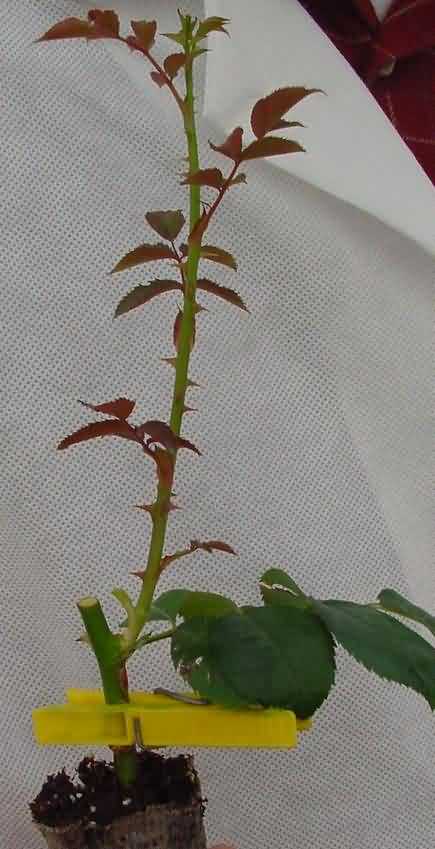 |
 |
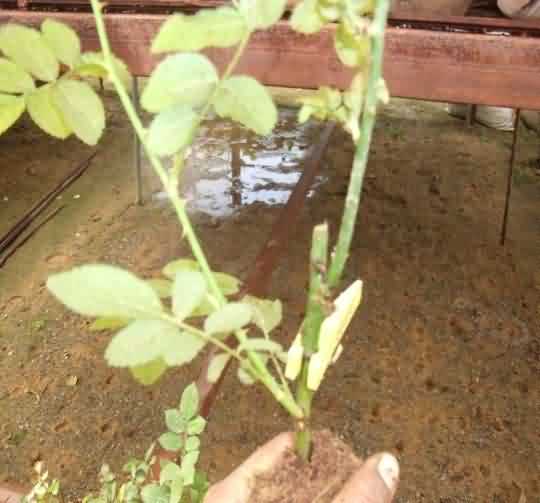 |
|
| Top graft of rose | |
Budded plants and Top grafts of rose plants should be 2 -3 months old and should be procured from authorized breeders for plantation at least 2.5 months before date of plantation. Planting material is available in poly bags and paper plugs.
Procedure for Planting Roses :
Bed Size:
Bed preparation for roses
Planting method:
Rose plant used for plantation should be two- three month old.& have minimum two dark green colour leaves. Bud union of rose plant should not be covered with soil, It should be 2 – 3 cm above the ground level. The sprout coming out of the union should face towards the path at the time of plantation. Rose plants are planted in a zigzag method on the bed. Planting distance: Plant to plant distance 17 cm and Row to Row distance 45 cm.
| Sr. No. | Area of poly house (m2) | Planting density | Total plants required |
| 1 | 560 | 7.5 plants/ m2 | 4200 |
| 2 | 1008 | 7.5 plants/ m2 | 7560 |
Special cultural practices :
For proper growth of rose plant and high production special cultural practices are to be carried out as follows:-
Initial plant development/ mother shoot bending:
If the young plant is allowed to flower immediately after planting there is serious risk that the important structural frame work of the plant will be impaired. The various types of plants require different treatment. First flower is pinched after one month from the date of plantation so that 2 to 3 eyes bud will sprout on main branch to grow as branches and these branches in turn will form buds. When the plant attains this stage of growth, the mother shoot is to be bent towards the direction of path. This cultural operation in rose plants is done to initiate bottom break ground shoot. The maximum leaf area is required to build up a strong root system. The mother shoot is bent nearer to the bud joint.
a. Plant structure development: To develop more growing points and plant structure development plays an important role. After planting ground shoot will start growing from crown of plant. The weak ground shoots should be bent at ground level, for forming a basic and strong frame work of plant structure for production throughout their life cycle. The strong ground shoots should be cut at 5th five pair of leaves after four and half months from the date of plantation. The medium ground shoots should be cut at 2nd or 3rd five of leaves.
b. Bending in roses:
Bending helps in maintaining enough leaf area on the plants. The maximum leaf area is required to build up a strong root system. Leaves are important for producing carbohydrates
Photosynthesis
6 H20 + 6 CO2 -------------------> C6 H12O6 + 6O2
The mass of leaves is also known as the lungs of the plant.
The growing suckers should be removed in order to check new growth on the bended stem. The buds should be removed from the bended stem in order to check the incidence of thrips and bud rot (botrytis). Only weak and blind shoots are selected for bending. Bending breaks apical dominance of the plant. It is continuous process and hence carried out throughout the life cycle. Bending should be such that the most of the stems lay below horizontal. In summer season it is generally advised not to go for bending as it provides favorable condition for mites incidence.
Bending is done on 1st or 2nd five pair of leaves. One can also grow roses in greenhouse without bending by keeping some blind shoots on plants in standing position for extra photosynthesis & uptake of water nutrients. While bending the stems, the care should be taken that the stem will not break and the leaves will not touch the soil on the bed.
 |
 |
| Bending in rose plantation | |
c. Disbudding :-
Standard varieties are those with one flower on each stem. But as nearly all varieties produce some side buds below the center bud. These side buds have to be removed. The removal of these buds is known as disbudding. It should not be done too early or too late. If done too early it may harm leaves and if done too late than large wounds in the upper leaf axil can take place. When bud attain Pea size and shows slight colour then it is right time to do disbudding.
For most spray varieties, the center crown bud is to be removed. Disbudding is generally done on weak stem so that it can convert itself to thick stem and in future cuts can be taken. Thick stem produce strong sprouts where as thin stem gives out weak sprouts.
Removal of unwanted vegetative growth from the axil of leaf below the terminal bud is called pinching. This helps to get good quality flowers and buds and avoids wastage of energy in the development of auxiliary bud if done at right stage and right time. It leads to apical dominance.
e. Wild shoot (root stock) Removal:-
Wild shoots are the unwanted growth that take place at the union on the root stock. They should be removed at the earliest as these will deplete nutrients and checks growth and development of plant. They should not be cut but removed from its union by pressing it with thumb in order to check its further sprouting.
Location of suckers as they would appear on budded rose.
The support system consists of bamboo/ GI pipes/ ‘L’ angles inserted on both sides of bed at start and end of the bed. Post are placed at intervals of 3m on both sides of the bed, along the sides of bed, fastened at the posts at 30 cm – 40 cm intervals are 14 gauge GI wires or plastic string to support the plant. Between the wires across the bed, thin strings can be tied to keep the width of the bed constant.
Support system makes intercultural operation easy & protects the buds from being damaged, by not allowing the stems bend into the path.
g. Pruning or under cutting:
Rose plant pruning or under cutting is necessary to decrease height of the plant. This is done in the month of June-July. Pruning or under cut is practiced to avoid short stem and weak sprouts.
h. Maintenance of beds:
In green houses roses are grown on raised beds. The fertile soil of the beds has a tendency to collapse into the path due to hosing by pipe, weeding and hoeing, friction with spray pipe doing spray etc. Hence maintenance of bed is to be done by adding fresh soil to bed or by shifting fertile soil from path to bed.
i. Weeding and loosening of the soil:
This is done with the help of long handed weeding hook (khurpi). This operation is helpful for removal of weeds, breaking the top layer of algae and to facilitate better air circulation in soil. This is to be done very carefully otherwise it may damage active roots.
j. Application of bud caps:
Bud caps are generally placed on the bud when they are of pea size. This helps to increase the bud size and shape to meet customer demand.
Application of bud cap in rose plantation
k. Removal of Dieback –
As the crop gets older (aged) dieback appear in the crop due to use of infected secateurs or wrong pruning practice or hard pruning. Due to which stem starts drying from place of cut towards bottom of the plant.
It should be removed from the crop time to time to keep the crop healthy. The secateurs should be dipped in bavistin solution to make it disinfectant everyday before starting and after harvest respectively.
Harvesting:
| S.No. | Particulars | Place of cutting | Month from date of plantation |
| 1 | Ground shoot cutting | At 5th five pair of leaves from bottom of plant | 3 to 3.5 |
| 2 | First harvesting | 2nd or 3rd five pair of leaves from first cut | 4.5 to 5 |
| 3 | Second/ Regular harvesting | 2nd or 3rd five pair of leaves from first cut | 6th month onwards daily harvesting |
The rose should be cut with the help of sharp cut & hold secateurs. Ground shoot cutting should be done on 5th five pair of leaf then one or two eye buds sprout from lower leaves below the cut. These sprouts will grow into flowers in the period of 35 to 50 days. This varies from variety to variety. Later on the first harvest should be taken on 2nd or 3rd five pair of the leaves above the first cut. During summer season or when there is less leaf area on plant it is always advisable to take cut on 3rd five pair of leaves above the first cut. Always bend thin stems and take cut on thick stems to get strong shoots.
The regular harvesting is done on 2nd five pair of leaves. Some times under cutting is also practiced as it is an important technique to keep rose plants at reasonable height. Harvesting cut should be sharp and inclined direction for avoiding the deposition of water or spray solution. When the temperature is low in the green house harvesting is done only once i.e. during early morning hours. When there is high day temperature it is necessary to take second harvesting in late afternoon.
Cut stages of roses play an important role in harvesting. Harvesting of rose is a skilled job hence required trained worker. Cut stages of roses for export is stage 0 & 1 where as cut stage is 2 & 3 for domestic market. In general 70 – 80 rose cut flowers should be kept in a bucket (50 liter capacity) contain 10 liters of clean chlorinated water or clean water containing preservatives like RVB chrysal or Florissant.
The stems not to be harvested –
- Disease and pest affected stems.
- Damaged stems.
- Stems below 35 cm stem lengths.
- Too weak and too thick stems.
- Bended stems.
- Bent neck and bull head buds.
The stems not harvested because of above reasons should be bent to increase leaf area on a plant.
Author:
Dr. Satya Narayan Choudhary
Asstt. Trainer,
International Horticulture Innovation and Training Centre, Durgapura- Jaipur
Email:

